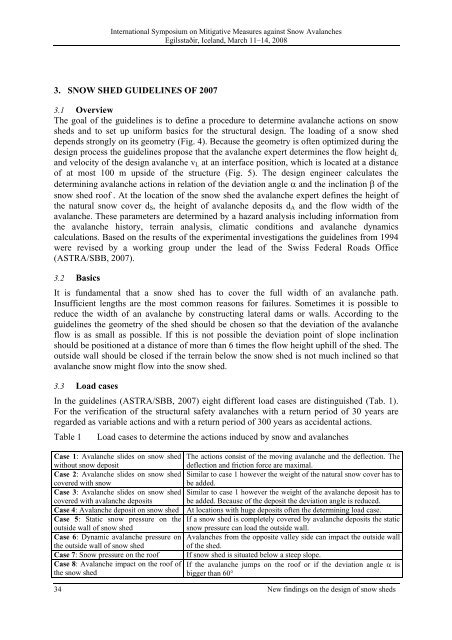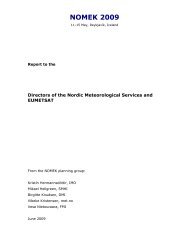International Symposium on Mitigative Measures against Snow ...
International Symposium on Mitigative Measures against Snow ...
International Symposium on Mitigative Measures against Snow ...
You also want an ePaper? Increase the reach of your titles
YUMPU automatically turns print PDFs into web optimized ePapers that Google loves.
<str<strong>on</strong>g>Internati<strong>on</strong>al</str<strong>on</strong>g> <str<strong>on</strong>g>Symposium</str<strong>on</strong>g> <strong>on</strong> <strong>Mitigative</strong> <strong>Measures</strong> <strong>against</strong> <strong>Snow</strong> Avalanches<br />
Egilsstaðir, Iceland, March 11–14, 2008<br />
3. SNOW SHED GUIDELINES OF 2007<br />
3.1 Overview<br />
The goal of the guidelines is to define a procedure to determine avalanche acti<strong>on</strong>s <strong>on</strong> snow<br />
sheds and to set up uniform basics for the structural design. The loading of a snow shed<br />
depends str<strong>on</strong>gly <strong>on</strong> its geometry (Fig. 4). Because the geometry is often optimized during the<br />
design process the guidelines propose that the avalanche expert determines the flow height dL<br />
and velocity of the design avalanche vL at an interface positi<strong>on</strong>, which is located at a distance<br />
of at most 100 m upside of the structure (Fig. 5). The design engineer calculates the<br />
determining avalanche acti<strong>on</strong>s in relati<strong>on</strong> of the deviati<strong>on</strong> angle α and the inclinati<strong>on</strong> β of the<br />
snow shed roof . At the locati<strong>on</strong> of the snow shed the avalanche expert defines the height of<br />
the natural snow cover dS, the height of avalanche deposits dA and the flow width of the<br />
avalanche. These parameters are determined by a hazard analysis including informati<strong>on</strong> from<br />
the avalanche history, terrain analysis, climatic c<strong>on</strong>diti<strong>on</strong>s and avalanche dynamics<br />
calculati<strong>on</strong>s. Based <strong>on</strong> the results of the experimental investigati<strong>on</strong>s the guidelines from 1994<br />
were revised by a working group under the lead of the Swiss Federal Roads Office<br />
(ASTRA/SBB, 2007).<br />
3.2 Basics<br />
It is fundamental that a snow shed has to cover the full width of an avalanche path.<br />
Insufficient lengths are the most comm<strong>on</strong> reas<strong>on</strong>s for failures. Sometimes it is possible to<br />
reduce the width of an avalanche by c<strong>on</strong>structing lateral dams or walls. According to the<br />
guidelines the geometry of the shed should be chosen so that the deviati<strong>on</strong> of the avalanche<br />
flow is as small as possible. If this is not possible the deviati<strong>on</strong> point of slope inclinati<strong>on</strong><br />
should be positi<strong>on</strong>ed at a distance of more than 6 times the flow height uphill of the shed. The<br />
outside wall should be closed if the terrain below the snow shed is not much inclined so that<br />
avalanche snow might flow into the snow shed.<br />
3.3 Load cases<br />
In the guidelines (ASTRA/SBB, 2007) eight different load cases are distinguished (Tab. 1).<br />
For the verificati<strong>on</strong> of the structural safety avalanches with a return period of 30 years are<br />
regarded as variable acti<strong>on</strong>s and with a return period of 300 years as accidental acti<strong>on</strong>s.<br />
Table 1 Load cases to determine the acti<strong>on</strong>s induced by snow and avalanches<br />
Case 1: Avalanche slides <strong>on</strong> snow shed The acti<strong>on</strong>s c<strong>on</strong>sist of the moving avalanche and the deflecti<strong>on</strong>. The<br />
without snow deposit<br />
deflecti<strong>on</strong> and fricti<strong>on</strong> force are maximal.<br />
Case 2: Avalanche slides <strong>on</strong> snow shed Similar to case 1 however the weight of the natural snow cover has to<br />
covered with snow<br />
be added.<br />
Case 3: Avalanche slides <strong>on</strong> snow shed Similar to case 1 however the weight of the avalanche deposit has to<br />
covered with avalanche deposits be added. Because of the deposit the deviati<strong>on</strong> angle is reduced.<br />
Case 4: Avalanche deposit <strong>on</strong> snow shed At locati<strong>on</strong>s with huge deposits often the determining load case.<br />
Case 5: Static snow pressure <strong>on</strong> the If a snow shed is completely covered by avalanche deposits the static<br />
outside wall of snow shed<br />
snow pressure can load the outside wall.<br />
Case 6: Dynamic avalanche pressure <strong>on</strong> Avalanches from the opposite valley side can impact the outside wall<br />
the outside wall of snow shed<br />
of the shed.<br />
Case 7: <strong>Snow</strong> pressure <strong>on</strong> the roof If snow shed is situated below a steep slope.<br />
Case 8: Avalanche impact <strong>on</strong> the roof of If the avalanche jumps <strong>on</strong> the roof or if the deviati<strong>on</strong> angle α is<br />
the snow shed<br />
bigger than 60°<br />
34 New findings <strong>on</strong> the design of snow sheds











